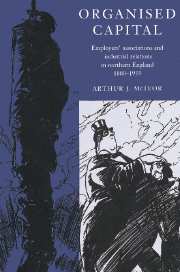Book contents
- Frontmatter
- Contents
- List of maps and tables
- Acknowledgements
- List of abbreviations
- Introduction
- Part 1 Setting the scene
- Part 2 Forging employers' organisations, 1880–1920
- Part 3 Reacting to the economic slump, 1920–39
- 7 The millowners' counter-attack
- 8 Stabilising labour markets: building
- 9 Defending managerial prerogative: engineering
- Conclusion
- Bibliography
- Index
8 - Stabilising labour markets: building
Published online by Cambridge University Press: 14 October 2009
- Frontmatter
- Contents
- List of maps and tables
- Acknowledgements
- List of abbreviations
- Introduction
- Part 1 Setting the scene
- Part 2 Forging employers' organisations, 1880–1920
- Part 3 Reacting to the economic slump, 1920–39
- 7 The millowners' counter-attack
- 8 Stabilising labour markets: building
- 9 Defending managerial prerogative: engineering
- Conclusion
- Bibliography
- Index
Summary
During and immediately after the First World War, the master builders had experienced a serious erosion of their authority and bargaining power. This was reflected in their failure to prevent upward wage escalation via sectional and local claims, the concession of generous working conditions and, perhaps most significantly, in the proliferation of closed shop agreements. The local employers' associations, regional federations and the NFBTE made concerted efforts to control this situation, but with little evident success. It was argued in chapter 6 that the building employers were critically weakened by the structure of their industry and the nature of their product markets. In particular, a large non-organised sector of predominantly small firms and disagreements over strategy within the organisation weakened the building employers in their relations with construction trade unions.
Market circumstances altered markedly in the following two decades. This chapter analyses the responses of building employers and their collective organisations to the inter-war economic crisis, focusing on their evolving relationships with their trade unions. The evidence suggests that the employers' associations managed to exploit changes in labour markets to regain authority and control at the point of production, though this stopped far short of any open attack upon building trade unionism. Quite the contrary. The building employers took the initiative to widen union recognition by extending collective bargaining procedures in the 1920s. The scope of substantive norms was also widened, notably through the formulation of a national wage grading scheme for the industry.
- Type
- Chapter
- Information
- Organised CapitalEmployers' Associations and Industrial Relations in Northern England, 1880–1939, pp. 211 - 232Publisher: Cambridge University PressPrint publication year: 1996

